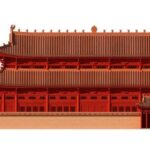In 2022, it has been 20 years since the Imperial Citadel of Thang Long was officially revealed in 2022. Millions of artifacts from dynasties Dai La, Ly, Tran, Le, Nguyen… have been found. Architectural ruins with the imprints of glorious dynasties in history appear one after another in the cultural layers of the archaeological pit. Up to now, the work of editing and studying artifacts and relics has been carried out by relevant units and is expected to be temporarily completed by 2025 to switch to a new method of restoration, conservation, and promotion of value by modern technology that we are used to calling “digitization”.
Editor’s note:
During his lifetime, President Ho Chi Minh paid special attention to the cause of preserving and promoting the national cultural heritage. The clearest proof is the fact that President Ho Chi Minh issued Ordinance No. 65/SL dated November 23, 1945, after he delivered the historic “Declaration of Independence” – ushering in an era of independence and freedom for the Vietnamese people. It can also be affirmed that this is the first Ordinance of our State laying the foundation for the conservation of the national cultural heritage.
On top of that, President Ho Chi Minh understood the material value as well as the spiritual value of cultural heritages, which are treasures that crystallize ideas and creative talents of the Vietnamese nation. With love for his homeland, country and strategic vision, he realized it was necessary to protect and preserve cultural heritage, because cultural heritage is the place that most clearly shows the soul of a nation, losing heritage, even a part, is to lose national identity.
The further back in time, the brighter the thought of President Ho Chi Minh. Inheriting and developing, 76 years later, on November 12, 2021, the Prime Minister signed Decision No. 1909/QD-TTg approving the Strategy for Cultural Development to 2030. On December 02, 2021, the Prime Minister continues to sign Decision No. 2026/QD-TTg approving the program to digitize Vietnamese cultural heritage in the 2021-2030 period. Within 21 days, the two decisions highlighted the importance of culture – the spiritual foundation of society, both as a goal and as a driving force for socio-economic development. Culture must be put on an equal footing and develop in harmony with the economy, politics and society; ensuring cultural and human factors in economic development; adapting to the development trend of the Fourth Industrial Revolution, new and modern technologies and socio-economic changes, people due to the impact of natural disasters, epidemics, crises…
In particular, the two decisions of the Prime Minister highlight the goal of “Protecting and promoting the national cultural heritage”, which emphasizes the task of “Digitalization and digital mapping of special national monuments, national monuments, national treasures, documentary heritage. Upgrading and exploiting effectively the data bank on cultural heritage of 54 ethnic groups in Vietnam in accordance with the requirements of the Fourth Industrial Revolution”; “Building a national database system on cultural heritage on a unified digital technology platform to serve the work of archiving, management, research, conservation, exploitation and promotion of heritage, sustainable tourism development promotion; ensuring integration into the e-Government architectural framework and the digital Vietnamese Knowledge System”; “Promoting digital transformation, implementing national digital data integration on cultural heritage, ensuring effective service for society and the community at all times and places.”
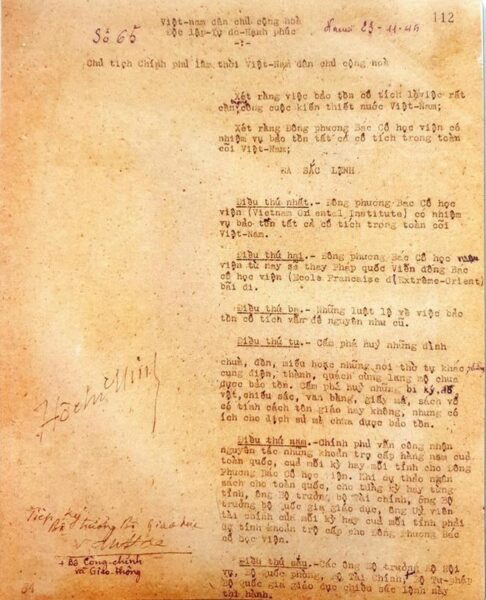
President Ho Chi Minh issued Ordinance No. 65/SL dated November 23, 1945 (the first Ordinance on the preservation of cultural heritage).
Ruins can speak…
Over 20 years, Hanoi has one more particularly important relic, which is a destination not to be missed by every tourist when visiting the capital. But when people come to Thang Long Imperial Citadel, do they understand the monumental scale and values of the archaeological site? It’s a question that not many travelers can confidently assert. It is only natural that very few people understand, because not everyone is an archeologist or a historical researcher. And even as a historian, not everyone understands the language of archeology. Even if they are archaeologists, very few people are lucky enough to directly participate in the “unprecedented” excavation more than 20 years ago on the old Parliament house so that they can be knowledgeable about the heritage which has been recognized by the United Nations Educational, Scientific and Cultural Organization (UNESCO).
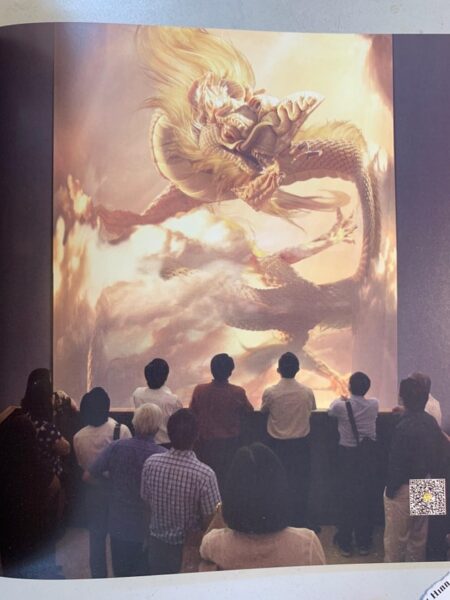
Displaying Flying Dragon Mapping of the Ly Dynasty in the corridor of the exhibition area “Underground archeological discoveries of the National Assembly House” (Photo: Citadel Research Institute)
Recently, in the role of “native guide”, we took some friends to visit Hanoi monuments for the first time they went to the Capital. Going all the way from Thang Long Tu Tran to Tran Quoc Pagoda, then Van Mieu – Quoc Tu Giam, everything was fine, until arriving at the Imperial Citadel, an argument arose. We, with all the knowledge gained as journalists – those who have the good fortune to witness from the first day of excavation at 18 Hoang Dieu site until all zones A, B, C, E with dragon heads, phoenix birds, lovebird tiles…. appeared in turn – tried to let our friends through the architectural ruins imagine an Imperial Citadel with all of its buildings.
3D simulation of the architectural form of the palace of the Ly Dynasty

“The Imperial Citadel Research Institute has simulated in 3D the architectural form of the palace of the Ly dynasty. This is the first time the hypothetical image of the palace architecture of the Ly dynasty after more than a thousand years has been reproduced. It serves as an example to help viewers better visualize and see more thoroughly the beauty and grandeur of the architectural scale in the ancient Thang Long Imperial Palace.”
Assoc. Prof. Dr. Bui Minh Tri (Director of Imperial Citadel Research Institute)
However, for those friends with “many questions”, it seems that our explanation (plus the explanation of the Thang Long Imperial Citadel Center) for each object on display seems to be insufficient. Luckily, we remembered a recently published work. In 2021, from the vestiges and architectural materials found in the Imperial Citadel, Assoc. Prof. Dr. Bui Minh Tri – Director of the Citadel Research Institute and his associates simulated in 3D the architectural form of the palace of the Ly Dynasty. This is the first time the hypothetical image of the palace architecture of the Ly dynasty after more than a thousand years has been reproduced. It serves as an example to help viewers (especially tourists) better visualize and see more thoroughly the beauty and grandeur of the architectural scale in the ancient Thang Long Imperial Palace. Of course, the debate is over at this point, and those friends who love to explore history are almost out of the question.
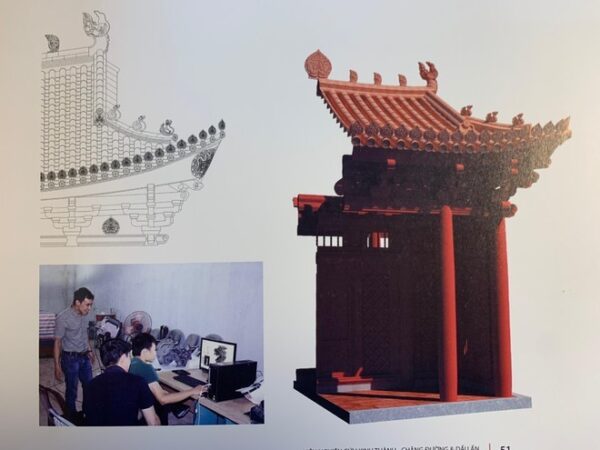
Remnants of the architectural foundation of the Ly Dynasty corridor in zone A – Thang Long Imperial Citadel relic site
If you want to understand the “mute” material, you must study
Bringing the above little story to a few historians and archaeologists in Hanoi, almost all of them laughed and said, it’s a very common thing. All those who first come into contact with the archaeological site of the Imperial Citadel have such opinion. Normally speaking, it is also because, according to the explanation of Assoc. Prof. Dr. Tong Trung Tin – Chairman of the Vietnam Archaeological Association, former Head of the archaeological excavation site 18 Hoang Dieu, the archeological material in theory is “dumb” material. The relics themselves cannot tell the value of Thang Long culture. Even archaeologists are required to go through a long, laborious and arduous research process. Not to mention the remaining archaeological sources are extremely meager. For example, Ly Tu Tan (fifteenth century) when talking about the literary legacy of Ly – Tran left behind at that time was “one or two out of a hundred thousand parts” (Ly Tran’s Poetry, 1977, page 55) inherent to it.
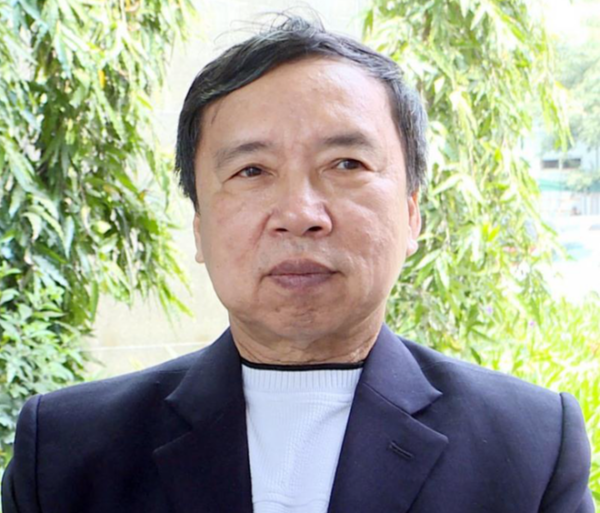 |
| Activities of measuring, drawing, photographing, documenting and researching to reconstruct the architecture using 3D technology |
Assoc. Prof. Dr. Bui Minh Tri – Director of the Imperial Citadel Research Institute also recounted that the most difficult moment of the Imperial Citadel of Thang Long was when the managers at that time were still wondering whether to keep it for conservation or fill it up after the archeological research is done. The reason for the confusion was because, at that time, few people were clear about the value of the giant architectural ruins. And to understand it, hundreds of internal and international conferences have been held to examine and discuss in the most scientific and objective way the value of the unique and special heritage of the capital. It is also a lot of activities to propagate awareness about the values, history and qualities of a world-class heritage.
Heritage digitization is a path

“There are many ways to preserve and promote the value of heritage, specifically here the physical heritage, for example building models, direct restoration and digitization is also a path. However, obviously, when there are not enough conditions for direct restoration, digitization is the most up-to-date way to preserve and promote.”
Assoc. Prof. Dr. Tong Trung Tin (Chairman of the Vietnam Archaeological Association, former Director of the Institute of Archeology, former Head of the archaeological excavation site 18 Hoang Dieu, Hanoi)
Assoc. Prof. Dr. Tong Trung Tin recalled: “At that time, at the gravel pillars in Zone A, we had to let workers stand in to represent the pillars, dozens of gravel pillars were represented by dozens of people. Only when some people stand there can we clearly imagine that at this position, it was a palace with a vast area in the Ly Dynasty. As a result, the intense debates about a “long corridor” or something definitely not a remnant of grand palace architecture immediately ceased.” We asked Prof. Dr. Tong Trung Tin who came up with the initiative for each worker to stand on a gravel pillar to make it easier to imagine, he laughed and said: “We learned the Japanese way when they excavate the ancient capital Nara, nowhere else!”.
More than 20 years have passed, technology has developed like a storm, 3D virtual reality software allows simulation, giving the most vivid images for each hypothesis about columns, truss, rafters, lath and roof, even the whole space of the ancient Forbidden City without having to ask workers to stand in to make it easy to visualize as before. And the simulation of the architectural form of the Ly Dynasty by the Citadel Research Institute is the most specific example because of the digital technology in the 4.0 era.
Digitization is inevitable
Up to now, we have had legal documents and directions from the highest levels of leadership so that the journey of culture and heritage digitization is implemented and met expectations. Specifically, on November 24, 2021, in his speech at the National Cultural Conference, General Secretary Nguyen Phu Trong emphasized, to continue to build, preserve, revive and develop the culture of our nation, we need to focus on performing well a number of key tasks, including: “Building a digital cultural environment suitable for the digital economy, digital society and digital citizenship, making culture adapting and regulating the country’s sustainable development in the context of the Fourth Industrial Revolution. Urgently develop cultural industries and build a healthy cultural market.
By December 2021, the Government issued Decision 2026/QD-TTg approving the program to digitize Vietnamese heritage in the 2021-2030 period. The decision also sets targets such as: 100% of tangible, intangible and documentary cultural heritages to be recognized by UNESCO; 100% of special national monuments are digitized and applied on digital platforms. 100% of national treasures and heritages in the National Intangible Cultural Heritage List are digitized, prioritizing digitization according to the needs of society. Along with that, it is considered the most important that “100% of professionals working in the cultural heritage industry are trained, retrained, updated knowledge and skills for digital transformation”.
Assoc. Prof. Dr. Tong Trung Tin said that there are many ways to preserve and promote the value of heritage, specifically the physical heritage, such as model building, direct restoration and digitization is also is a path. But obviously, when there are not enough conditions for direct restoration, digitization is the most up-to-date way to preserve and promote. Assoc. Prof. Dr. Bui Hoai Son – Standing member of the National Assembly’s Committee for Culture and Education, expressed his opinion that we are living in a very special environment and social situation. This current society is being dominated by many factors related to digitization.
Therefore, when it comes to digital society, digital economy, and digital citizenship, we must definitely mention digital culture. There, digitized data is an important resource that can handle many things, not only stored and disseminated in the current society and becomes the data for future but also serves more than these. Stemming from all the above reasons, the world recently had a saying: “Data is the new oil”. This proves that, in today’s society, data is especially important. To do so in the cultural sphere, of course, it must be digitized.
Along with digital society, digital economy and digital citizenship, there must also be digital culture

“When it comes to digital society, digital economy, digital citizenship, we must definitely mention digital culture. There, digitized data is an important resource that can handle many things, not only stored and disseminated in the current society and becomes the data for future but also serves more than these many things, not only stored and disseminated in the current society, but also more than that. To do so in the cultural sphere, of course, it must be digitized.”
Assoc. Prof. Dr. Bui Hoai Son (Standing member of the National Assembly’s Committee for Culture and Education)
No one doubts the importance of digitization anymore, the important thing is, where do we start, how and when to start. This is important, so we should start as soon as possible. However, Assoc. Prof. Dr. Bui Hoai Son affirmed, it is necessary to have a clear strategy.
How to digitize heritage and why is it necessary?
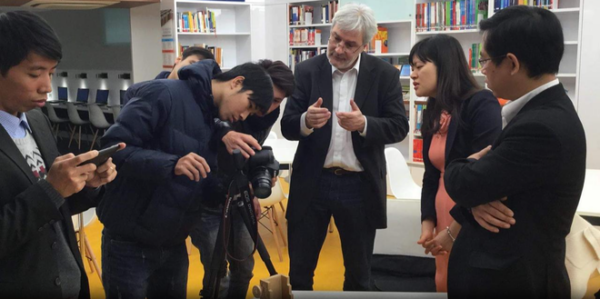
In the world, the revenue from the exploitation of “virtual” artifacts, “virtual” heritage … at many museums and monuments is very high. However, in Vietnam, this form has just begun and is experimental. Assessed to bring a lot of potential in the future, the Culture industry is gradually implementing the digitization of cultural heritages, bringing antiquities and relics into cyberspace. However, to really attract the public and open up effective socio-economic exploitation sources, is the application of technology enough? Mr. Hoang Quoc Viet – Chairman of the Board of Directors cum CEO of Viet Professional Software Solutions Joint Stock Company (Vietsoftpro) – a unit that cooperates with the National Museum of History to digitize 23 national treasures had a discussion with An Ninh Thu Do Newspaper about this content.
Let the value of cultural heritage sublimate
– Reporter: Where did you get the idea and approach to digitize the national heritage?
– CEO of Vietsoftpro Company Hoang Quoc Viet: The work of digitizing world heritage has been long ahead of us. In 2002, 20 years ago, while studying in India, I already saw them digitizing their cultural heritage. They did it methodically and scientifically by bringing in technology, the most modern technology is always for culture first. Anyone who goes to museums abroad will see it right away – that’s where their country showcases its technology. As for us, on the contrary, the museum is purely for display work.
We have done the digitization of 23 national treasures. When it comes to national treasures, those are the best cultural heritages. They all have their own stories and can all be applied to other industries, like education. To do that, we have to coordinate with history experts to program, so that when students interact with the material, they will understand all the history lessons in a visual and vivid way. Therefore, right from the time of working with the National Museum of History, we propose to pilot digitize the best artifacts and heritage. Each artifact and each heritage must contain in it stories for new technology to sublimate and bring into full play its potential. Once done, the goal is not only to introduce in the Cultural sector but also to be applied in schools. Our criterion at that time was that the heritage digitization when compared to the US must be equal in technology, but more prominent in cultural values. As a result, the product, when introduced into the school system, was positively received by the students.
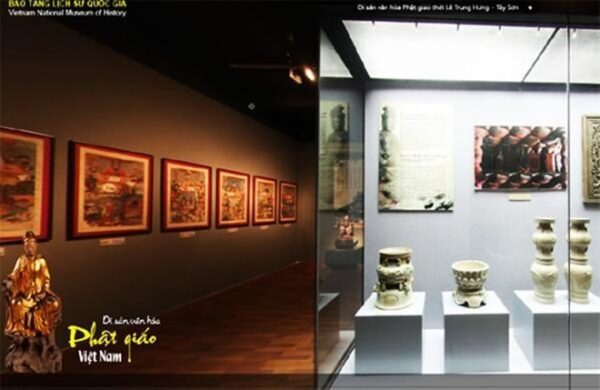
Vietnamese experts in 3D technology research in collaboration with Hafencity University (Germany) applied heritage digitization to museum work
“Input materials” exploitation has not been paid attention
– As an expert in the field of technology, having been “immersed” in 3D interactive software solutions in the field of cultural heritage, are you glad that the Government recently decided to approve Vietnam Cultural heritage digitalization program?
– Digital transformation or digitization is a problem we talk about with many industries, including the cultural sector, but it has not been done for many years. If you want to do digital transformation, you must first digitize and have digital data. Because without those things, banks, systems, software … will not be effective, especially in the field of cultural heritage. Culture is an extremely important field because it affects most industries and is the foundation of all industries. For example:
– For the tourism industry, culture is the “input”. To promote tourism, it is necessary to find destinations with beautiful heritage, beautiful culture, beautiful landscapes of the country and people. Our country has a lot of beautiful heritages, which are internationally recognized and ranked, but how do visitors see and approach it in the most intuitive way to have a demand for experiencing it in person? The answer is to digitize the legacy to bring it closer to potential customers.
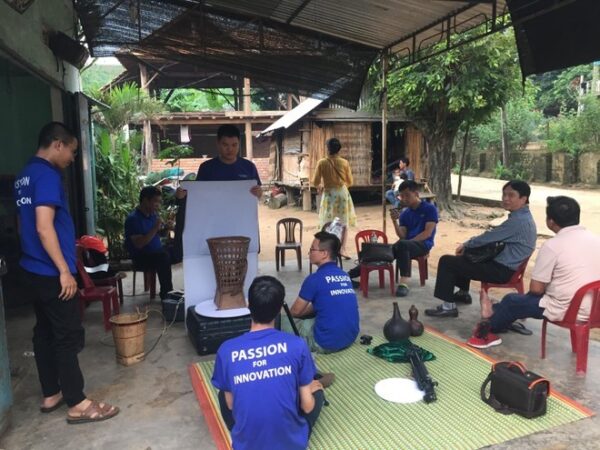
3D Museum of Vietnamese Buddhist Cultural Heritage
– For Education, specifically History subject, why do students always say this is a boring subject? It is because we do not have data or have incomplete data about the culture of this subject. Vietnam has a lot of historical sites, many national treasures… but if the students want to see them, they have to go to the museum, because there is no way to access it them at school. Now, if it is possible to digitize everything into 3D images or things vividly and attractively, it will be extremely convenient for them, because, in sense, social subjects are all attractive.
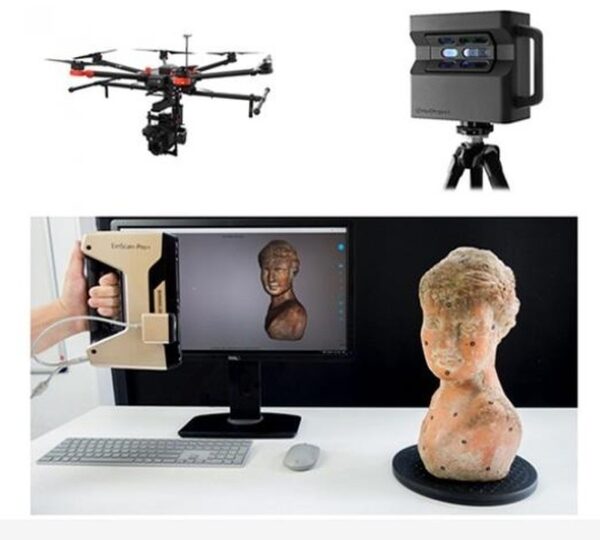
Digitizing artifacts of the Bana ethnic group – KonTum
That said, if the heritage is digitized, it will provide the Education sector with a very favorable foundation in teaching. I would like to briefly analyze the positive side of the application of digitization to prove that the Culture sector must be given priority before other industries in this regard, but in reality it is always behind. In the past, we used to think that the industry that brought economic benefits first should have to be done first, but this way of doing it from the top is not the case. When we set a target to develop tourism and invested heavily in it, we eventually discovered the lack of “input materials”, that’s because we did not pay attention to cultural “materials”.
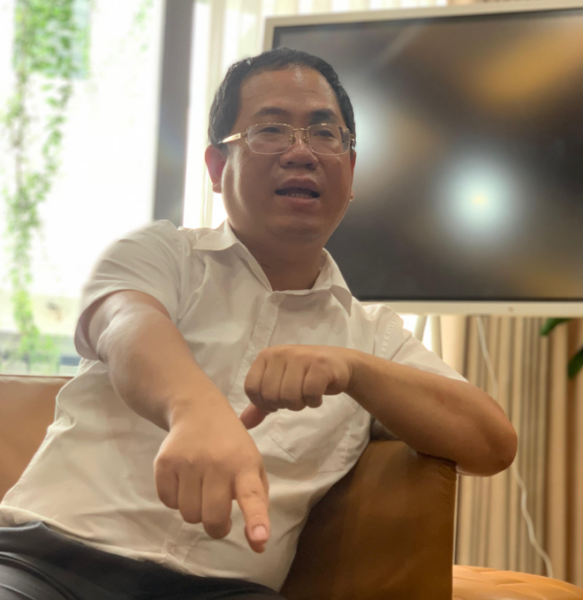
Optimal and comprehensive digitization solutions (2D, 3D, AR/VR) for the conservation and promotion of cultural heritage values
The Government has the policy of “Upgrading and exploiting the data bank on cultural heritage; building a national database system on cultural heritage on the basis of digital technology, ensuring that it can be integrated into the e-Government architectural framework and the digital Vietnamese knowledge system”, which is very encouraging. Nevertheless, from the perspective of a technologist, to be honest, I still feel sorry because this should have been implemented a long time ago.
We have cooperated with the Culture sector to digitalize museums and monuments for 10 years, so we hope to have policies like this from the Government level. Because at the local level, it is necessary to have corridors and bases for implementation in order to deploy. Before that, if we dit it, it would only be spontaneous and fragmented, lacking in consistency and synchronization. For instance, the fact that we cooperate with the museum to digitize heritage and artifacts … is first of all for our passion, but has not become a mandatory job to get adequate attention and investment.
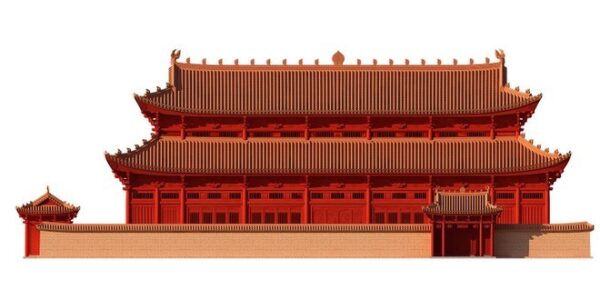
“Up to now, many people still think that digitizing cultural heritage is a very simple job, but completely do not understand the nature of digitization. I know a lot of “digitization programs” (which are actually documentation) that after being completed are stored in drawers but not exploited or promoted. They advocate the application of information technology and call it digital transformation or digitization but it is not correct. Digital transformation or digitization has a larger meaning, it goes beyond the technology shell.
Mr. Hoang Quoc Viet (CEO of Vietsoftpro Company – the unit in collaboration with the National Museum of History has digitized 23 national treasures)
Stories of today and tomorrow
– Digitization of heritage can be understood as the synthesis and construction of digital databases on artifacts, monuments, relics, historical sites… of the cultural sector. Do you think that, in the next 10 years, the Culture sector will accomplish the goal of this massive workload?
– Cultural heritage abounds, but it’s not like other fields. Specifically, if you want to digitize a paper document, most people think that just scanning it is enough. But when a paper document becomes a cultural heritage, it requires a story around it. The story is the intangible element that coexists with the paper text. To understand deeply the concept, the scanning of paper documents is merely documentation, not digitization. Or like digitizing a bronze drum, if you only take pictures, scan 3D graphics, it is simply archiving.
But if we build a story about the process of formation, how valuable the pattern of the drum is, how important the mark of existence throughout the history of the drum is… it requires a lot of historians and archaeologists involved. Converging all, digitizing the heritage has the meaning of preserving and promoting the value. A complete digitization of heritage, in addition to documenting it digitally and technologically, requires the cooperation of many researchers of history, culture, museums, etc. to build the story to serve economic and social exploitation, which is also the cultural industry.
Up to now, many people still think that digitizing cultural heritage is a very simple job, which is because they do not understand the nature of digitization. The Government’s program to digitize Vietnam’s cultural heritage has a vision to 2030, but I think that milestone is only for the implementation to be phased. If we start immediately, understand it correctly, do it right, synchronize the work of digitizing heritage, it will not be finished even by 2050.
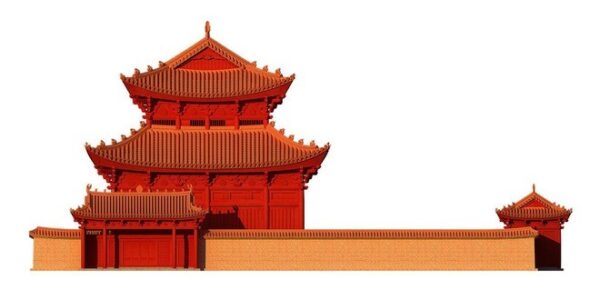
Palace architecture of the Ly Dynasty (reconstructed drawing of the Imperial Citadel Research Institute)
Technology is the last step
– That means we will have to do it longer, because there may be undiscovered cultural heritages. Later, when we find them, the work will continue, even the next generations will continue to do it for the rest of their lives. It’s a long, long story, for today and tomorrow, isn’t it, sir?
– Right! We do and our children and grandchildren will inherit and continue. The problem now is that we need to have a profound change in perception about the task of digitizing heritage, but I see that many agencies and units assigned to implement this still consider this a very vague and simple task. They think that the digitization work will be done by technology companies. It is not the case. Technology is just the last step. First, we need to do heritage statistics and research. It is wrong to think that technology should go ahead because technology is merely a means to an end. Here, scientists have to work first, finish building, and in the process use technology as a tool to carry out the task. But it must also be affirmed that in order to smoothly coordinate the digitization of heritage, technology workers must understand culture, and at the same time, cultural experts must also update their technology skills to serve their research and construction.
Digitizing to preserve and promote heritage values
– What do you evaluate the digitization work of heritage management agencies and localities today?
– In reality, the agencies assigned to carry out the digitization of the heritage simply hire technology enterprises to do it instead. It may sound an exaggeration, but the reality is that they just “aggressively” bring their cameras to take pictures, use scanners to make a few 3D images and then assume that the digitization is done. Honestly, if it was just that, it wouldn’t bring any value. As I have already stated, what we need is a profound change in perception.
First of all, the question is that what is the use of digitizing heritage? The post-digitization of heritage must be effective. But if we want to promote it, we need to return to the issue of having a story, having an intangible element, that is the value of heritage. I know a lot of “digitalization programs” (which are actually documentation) that after being completed are stored in drawers but not exploited or promoted. They advocate the application of information technology and call it digital transformation or digitization but this is not correct. Digital transformation or digitization has a larger meaning, it goes beyond the technology shell. I would like to emphasize that, even if we invest in digitizing thousands of artifacts, hundreds of cultural heritages, spend a lot of money to do it, they will not be valuable without their core content and stories. Hence, instead of rampant implementation, we should firstly work with the typical heritage, national heritage, do research, documentation, digitization, build the complete stories, then share, exploit the digital data to achieve higher efficiency. That is the true digital transformation – digitization to preserve and promote heritage values.
(to be continued)
Van Que – Ta Minh – Tran Quan – Tuan Dung

